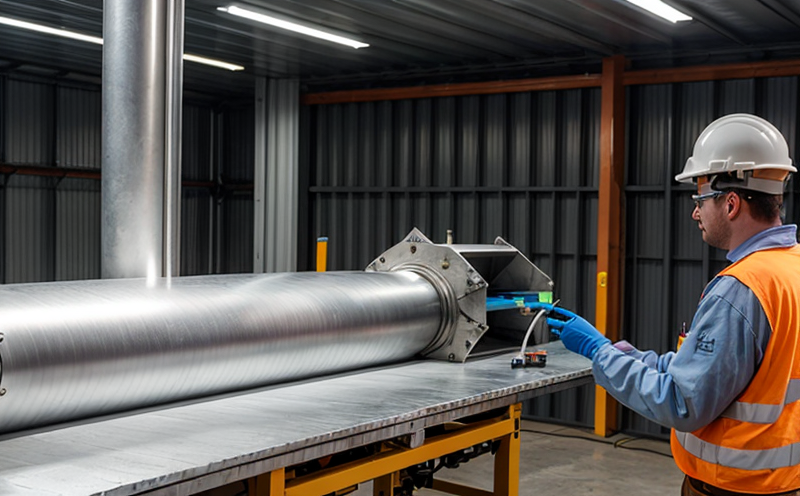ASTM D7137 Residual Strength after Impact Testing Validation Method Development Test
The ASTM D7137 standard provides a validated method to determine the residual strength of materials and components subjected to impact forces, which is critical for ensuring safety and reliability in renewable energy applications. This testing method assesses how well materials can withstand mechanical stresses following an impact event.
This service is particularly relevant in sectors like wind turbine blades, solar panels, and other large-scale renewable energy systems where structural integrity under dynamic loading conditions must be guaranteed. For instance, in the case of wind turbines, sudden gusts or collisions with birds could cause localized damage to the blade structure. Understanding the residual strength after such events helps manufacturers design more resilient components.
The ASTM D7137 test involves subjecting a specimen to an impact force and then measuring its ability to maintain structural integrity post-impact. The test is conducted using specialized equipment that simulates real-world conditions as closely as possible. This ensures that the results are both accurate and applicable to actual field performance.
The testing protocol outlined in ASTM D7137 includes detailed instructions on specimen preparation, application of impact force, and subsequent evaluation of residual strength. Specimens must be prepared according to specific dimensions and tolerances defined by the standard. After applying an impact force, the sample is inspected for any visible damage or changes in structural integrity.
The acceptance criteria are strictly defined within ASTM D7137, ensuring consistent results across different laboratories performing this test. Compliance with these standards not only enhances reliability but also facilitates regulatory compliance and market entry into various jurisdictions that recognize these international norms.
Understanding the implications of residual strength after impact is crucial for optimizing material selection and design in renewable energy systems. By leveraging ASTM D7137, stakeholders can ensure they are using materials capable of withstanding the rigors of real-world operation without compromising on performance or safety.
This testing method plays a vital role in advancing the technology used in renewable energy applications by providing data that informs critical decisions about material durability and component design. It supports continuous improvement efforts aimed at enhancing overall system reliability, thereby contributing to more sustainable and efficient use of resources.
The ASTM D7137 validation process ensures that tests conducted meet stringent quality standards set forth internationally. This consistency across testing environments enhances confidence in the results generated from this procedure. As renewable energy continues to grow in importance, ensuring robustness against potential failures becomes increasingly critical, making ASTM D7137 an indispensable tool for industry professionals.
By adhering to this standard, manufacturers can demonstrate their commitment to producing high-quality products that meet rigorous performance expectations. This not only builds trust with end-users but also positions them favorably in competitive markets seeking reliable suppliers of renewable energy components.
Scope and Methodology
The ASTM D7137 standard specifies a validated method for determining the residual strength of materials and components after they have been subjected to an impact force. This test is essential in ensuring that structures used in renewable energy applications can maintain their integrity following mechanical stress events.
- Specimens are prepared according to precise dimensions specified by ASTM D7137.
- An impact force is applied using specialized equipment designed to simulate real-world conditions accurately.
- The specimen's ability to retain its structural integrity post-impact is evaluated visually and through other non-destructive means.
Acceptance criteria are strictly defined within ASTM D7137, ensuring consistent results across different laboratories performing this test. Compliance with these standards not only enhances reliability but also facilitates regulatory compliance and market entry into various jurisdictions that recognize these international norms.
The testing protocol outlined in ASTM D7137 includes detailed instructions on specimen preparation, application of impact force, and subsequent evaluation of residual strength. Specimens must be prepared according to specific dimensions and tolerances defined by the standard. After applying an impact force, the sample is inspected for any visible damage or changes in structural integrity.
The acceptance criteria are strictly defined within ASTM D7137, ensuring consistent results across different laboratories performing this test. Compliance with these standards not only enhances reliability but also facilitates regulatory compliance and market entry into various jurisdictions that recognize these international norms.
Quality and Reliability Assurance
The ASTM D7137 standard plays a crucial role in maintaining high levels of quality and reliability within the renewable energy sector. By following this validated method, laboratories ensure consistent and accurate results, which are essential for making informed decisions regarding material selection and component design.
Consistency across testing environments is enhanced by adhering to ASTM D7137 standards, building confidence in the test results generated from this procedure. This consistency is particularly important given the growing importance of renewable energy technologies in addressing global environmental challenges.
By leveraging ASTM D7137 validation methods, manufacturers can demonstrate their commitment to producing high-quality products that meet stringent performance expectations. This not only builds trust with end-users but also positions them favorably in competitive markets seeking reliable suppliers of renewable energy components.
The ASTM D7137 standard ensures that tests conducted meet rigorous quality standards set forth internationally. This consistency across testing environments enhances confidence in the results generated from this procedure. As renewable energy continues to grow in importance, ensuring robustness against potential failures becomes increasingly critical, making ASTM D7137 an indispensable tool for industry professionals.





